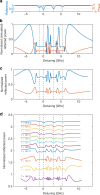Chip-scale atomic diffractive optical elements
- PMID: 31316075
- PMCID: PMC6637105
- DOI: 10.1038/s41467-019-11145-5
Chip-scale atomic diffractive optical elements
Erratum in
-
Publisher Correction: Chip-scale atomic diffractive optical elements.Nat Commun. 2019 Aug 12;10(1):3683. doi: 10.1038/s41467-019-11529-7. Nat Commun. 2019. PMID: 31406112 Free PMC article.
Abstract
The efficient light-matter interaction and discrete level structure of atomic vapors made possible numerous seminal scientific achievements including time-keeping, extreme non-linear interactions, and strong coupling to electric and magnetic fields in quantum sensors. As such, atomic systems can be regarded as a highly resourceful quantum material platform. Recently, the field of thin optical elements with miniscule features has been extensively studied demonstrating an unprecedented ability to control photonic degrees of freedom. Hybridization of atoms with such thin optical devices may offer a material system enhancing the functionality of traditional vapor cells. Here, we demonstrate chip-scale, quantum diffractive optical elements which map atomic states to the spatial distribution of diffracted light. Two foundational diffractive elements, lamellar gratings and Fresnel lenses, are hybridized with atomic vapors demonstrating exceptionally strong frequency-dependent, non-linear and magneto-optic behaviors. Providing the design tools for chip-scale atomic diffractive optical elements develops a path for compact thin quantum-optical elements.
Conflict of interest statement
The authors declare no competing interests.
Figures




References
-
- O’Shea, D. C., Suleski, T. J., Kathman, A. D., Prather, D. W. & Society of photo-optical instrumentation engineers. Diffractive Optics: Design, Fabrication, and Test (SPIE—The International Society for Optical Engineering, Bellingham, Washington, 2004).
-
- Segal N, Keren-Zur S, Hendler N, Ellenbogen T. Controlling light with metamaterial-based nonlinear photonic crystals. Nat. Photonics. 2015;9:180–184. doi: 10.1038/nphoton.2015.17. - DOI
LinkOut - more resources
Full Text Sources
Research Materials

